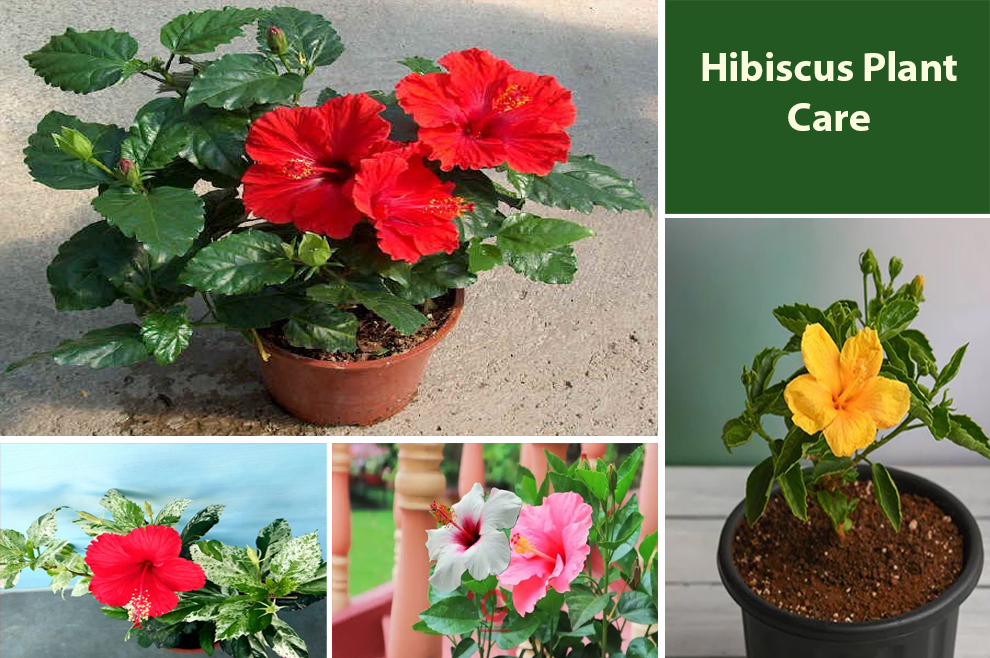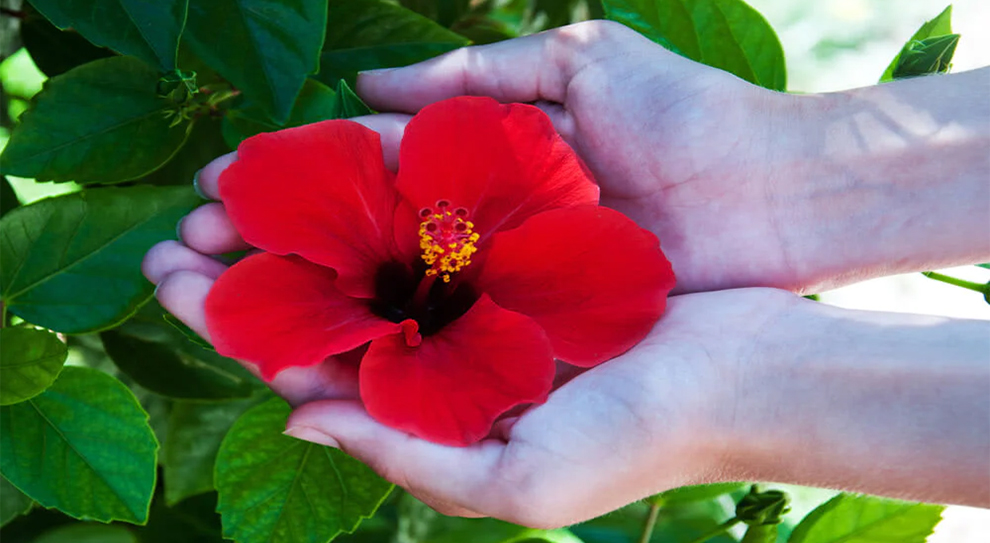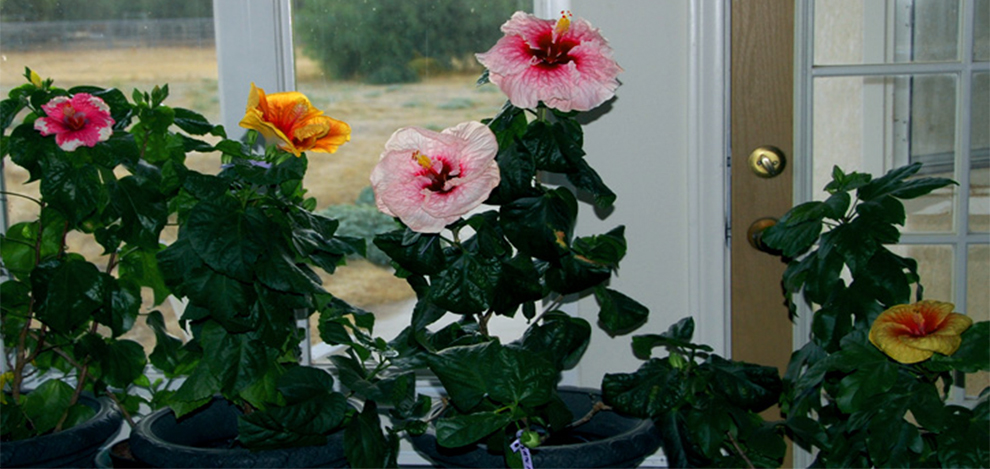How To Do Hibiscus Plant Care For Colorfol Flowering?
After planting hibiscus in well-draining soil, put them in bright light and use a slow release fertilizer. Always check the soil before rewatering to prevent waterlogging.

Hibiscus is popular among plant enthusiasts and gardeners because of its showy, beautiful flowers and ease of care.
Hibiscus plant care begins with constant exposure to direct, bright sun and warm temperatures. The soil where you plant your hibiscus must be well draining to remain constantly moist but never waterlogged.
Make sure to keep hibiscus pots in a spot with temperatures between 60 and 90 degrees Fahrenheit. While watering, water deeply enough to ensure the water reaches the roots.
Fertilize it regularly to promote flowering and healthy growth. A balanced plant food with a 10-10-10 or 20-20-20 formula works best. You can apply it every two to three weeks during the growing season.
Ideal Conditions for Hibiscus to Thrive – How to take care of a Hibiscus tree?
Fortunately, the hibiscus trees are easy to grow and care for. But they do need some specific conditions to thrive. Plenty of bright, direct sun, well-draining, moist soil, and warm temperatures are vital. The plant also needs pruning and regular fertilization to promote healthy growth and flowering.
They can be sensitive to pests and environmental changes. Thus, you must monitor them regularly for signs of stress or damage. Those who reside in cold temperatures must consider bringing the plant indoors during winter.
With good attention and care, hibiscus plants can be a rewarding addition to your indoor plant collection or garden. Let’s look at how to take care of hibiscus plant and its different needs below:
A. Water – How Often Do You Water Hibiscus?
Water the hibiscus trees deeply at least once or twice a week, depending on the soil conditions and the climate. They must be moist, not waterlogged. To determine when to water, inspect the soil by inserting the finger about two to three inches into the soil.
You can rewater if the soil feels dry at the touch. You may want to water the hibiscus trees more frequently during dry and hot weather. Do not overwater because it may lead to root rot and other issues.
B. Sunlight – How Much Sun Does A Hibiscus Need?
As part of the hibiscus plant care, you must give it plenty of sunlight to thrive. Ideally, you must keep them in a spot that receives at least six hours of direct sun daily. But in dry and hot climates, they can benefit from partial shade during the hottest parts of the day.
When growing hibiscus indoors, place them near a sunny window with ample direct sun around the day. The absence of adequate sun can make the hibiscus plant leggy and not produce enough flowers.
C. What Kind Of Soil Do Hibiscus Prefer?
Hibiscus plants cherish a well-draining soil rich in organic matter. The soil ought to be slightly acidic for adequate plant growth. Ensure the pH is between 6.0 and 7.0. You should avoid heavy clay soils that retain water. It may lead to root rot. You can amend the soil for hibiscus tree care with sand, perlite, or compost if the soil does not drain well and is heavy.
D. Fertilizer – Ideal Plant Food For Hibiscus
Apply the fertilizer every four to six weeks from spring to fall during the growing season. Ensure that you follow the instructions on the fertilizer package to avoid overfeeding, as this may lead to salt build-up, amongst other issues. Further, you can supplement with a bloom-boost fertilizer rich in phosphorus. It can help with more flowering.
E. How To Care For A Hibiscus Tree With Changing Temperature & Humidity?
Hibiscus plants cherish warm temperatures between 60 and 90 degrees Fahrenheit. They like the daytime temperature of 75 and 85 degrees Fahrenheit and the night temperature of 60 and 65 degrees Fahrenheit.
You must take measures to guard the hibiscus plants against extreme temperatures, both hot and cold, as they can damage and cause stress to the plant.
The correct humidity is also crucial for hibiscus care. Hibiscus varieties prefer a relative humidity of 50 percent or higher. The plant may suffer from reduced flowering and leaf drop if the air is too dry.
To increase humidity, mist the leaves regularly with water, place a tray of water near the plant or insert a humidifier. Do not place hibiscus plants in areas with cold drafts or air conditioning. It can inflict stress on the plant.
F. Hibiscus Pruning
Pruning is a crucial aspect of hibiscus plant care and can help promote healthy growth and flowering. Here are some tips for pruning the hibiscus:
- Timing: Prune the hibiscus in early spring or late winter before the new growth shows. It helps boost new growth and flowering in the upcoming season.
- Deadheading: Remove the spent flowers regularly to promote new flower growth. Chop off the entire flower, including the stem, slightly above the first set of leaves.
- Shaping: With pruning shears, start shaping the plant and remove any broken or dead branches. You can also prune the branch tips to encourage branching and a fuller plant.
- Size control: When the plant gets too large, prune it back up by 1/3rd of the overall size. It can help control its growth and promote more bushy but compact growth.
Always use a clean, sharp pruning tool and make clean cuts to avoid damaging the plant. Additionally, do not prune during early winter or fall, as that can remove the buds that will yield flowers in the spring.
G. Repotting Hibiscus
Repotting the hibiscus every one to two years or when they have outgrown its existing container is needed. Here are some tips for repotting the hibiscus for effective hibiscus plant care:
- Timing: The best time for repotting the hibiscus plants is spring before the growing season starts.
- Container size: Pick a new container: one size larger than the current one. Hibiscus plants cherish slightly tight quarters. So, do not choose a pot that is too large.
- Repotting: Gently remove the plant from the container and cautiously loosen the roots. Plant the plant in a new container and fill it with soil. Ensure you leave an inch of space at the top of the container.
- Watering: Water the plant thoroughly after repotting to help the soil settle and prevent air pockets. Keep the soil moist but not waterlogged for the first few weeks after repotting.
For hibiscus tree care, move this newly repotted plant to a bright, warm location away from direct sun for a few days to allow the plant to adapt to the new environment.
Pests & Disease Protection For Hibiscus
Hibiscus plants can be susceptible to various pests and diseases. Here are the tips you can take to guard them:
- The hibiscus plants can be affected by pests like spider mites, aphids, mealybugs, and whiteflies. To control these pests, spray the plant with a gentle insecticidal soap or neem oil. Regularly inspect the plant for pest signs and take action promptly to avoid infections from becoming severe.
- Hibiscus plants can be susceptible to diseases like powdery mildew, fungal leaf spot, and root rot too. To dodge these diseases, avoid overhead watering.
It may become a breeding ground for fungal infections. Also, ensure that the hibiscus plant grows in well-draining soil and that the leaves and flowers have good air circulation around them.
Act promptly for hibiscus plant care if you notice any signs of diseases, such as yellow or brown spots on the leaves. You can prevent pest and disease problems by keeping the plant healthy and well-maintained.
Regularly prune the plant to remove damaged or dead branches and ensure it grows in well-draining soil with good irrigation. Fertilize regularly to promote healthy growth.
Tips For Hibiscus Tree Care

Here are some tips for caring for your hibiscus plant better:
- Consistent care routine: Hibiscus plants thrive on consistency. So, establish a regular care routine and adhere to it.
- Protecting the plant from extreme weather conditions: Hibiscus is sensitive to extreme weather conditions. So guard them against harsh rain, winds, and extreme temperature. If you reside in an area with high winds, plant the hibiscus near a windbreak, such as a wall or a fence.
- During heavy rain, ensure that the plant is not sitting in water and is in well-draining soil. In extreme heat, guard the plant with shade or move to a cooler spot.
- Providing adequate light: Hibiscus cherishes ample sun to bloom and grow. Ensure you keep the plant in a spot that receives at least six hours of direct sun daily. When growing indoors, keep it near a south-facing window.
Alternatively, you can use artificial grow lights. But be cautious, and do not expose the plant to too much direct sun, as that may lead to leaf burn. - Monitoring for signs of stress or damage: Regularly monitor the plant to catch any issues with the plant before they become severe. Monitor for discoloration, wilting, dropping or yellowing leaves, or pests. When you notice these signs, act immediately by adjusting the fertilization or watering schedule, using a fungicide or pesticide, and pruning the damaged branches or leaves.
- Winter protection: Those residing in colder areas should guard the hibiscus against freezing and frost temperatures. You can bring the plant indoors, put it in a greenhouse, or cover it with a protective material or blanket if it is too large to move.
- Air circulation: Good air circulation is crucial for hibiscus to avoid fungal diseases and promote healthy growth. Do not place the plant in a spot with poor or stagnant ventilation.
- Pest control: Monitor the plants and take steps to avoid pest infestations. Do not over-fertilize, as that attracts pests. You can opt for natural pest control measures like insecticidal soap or neem oil to guard the hibiscus tree.
- Mulching: Add a thick organic mulch layer around the tree’s base to help it retain moisture, suppress weeds, and provide nutrients as the mulch breaks down. You can use a 2-3 inch mulch layer comprising compost or shredded bark. Do not pile the mulch against the trunk.
How To Care For A Hibiscus Tree In Spring?
Give your hibiscus plant a good start in the growing season by caring well in the spring. So prune any damaged or dead leaves, apply a slow-release plant feed, and check the soil moisture levels. As the weather warms up, gradually increase the watering frequency and ensure the plant gets adequate sun.
You can consider repotting if the plant has outgrown the current container. Watch out for pests and diseases and act if you notice any signs. The hibiscus will be on to a healthy growing season with proper spring care.
Potted Hibiscus Tree Care In Winter

Guard the plant against cold temperatures during winter. Consider bringing the potted plant indoors or in the greenhouse if possible, and keep it in a bright, sunny spot.
Lower the watering and do not let the soil dry completely. You can consider pruning the hibiscus to remove the damaged or dead leaves.
Water out for pests, as they can be prevalent when potted plants are indoors. With proper winter care, your plant will survive the cold months and get ready for the next growing season.
Related: How long do hibiscus plants live?
Hibiscus Tree Care Outdoor vs. Indoor
You can grow hibiscus both indoors and outdoors. However, the care requirements may vary slightly depending on where you plant them. Outdoor hibiscus demands more sun and water than indoor plants.
When outdoors, plant them in a spot where they get at least six hours of direct sun every day. Further, water them regularly, especially during the dry and hot periods.
Indoor hibiscus does not need a lot of sun and water, but you must still place them in a sunny, bright spot and water them anytime the topsoil feels dry. Both indoor and outdoor hibiscus benefit from regular feeding and pruning to promote healthy growth.
We’d like to conclude by saying that it is vital to know how to care for a hibiscus plant. With proper care the plant blooms to have colorful flowers enhancing the beauty of any space.
